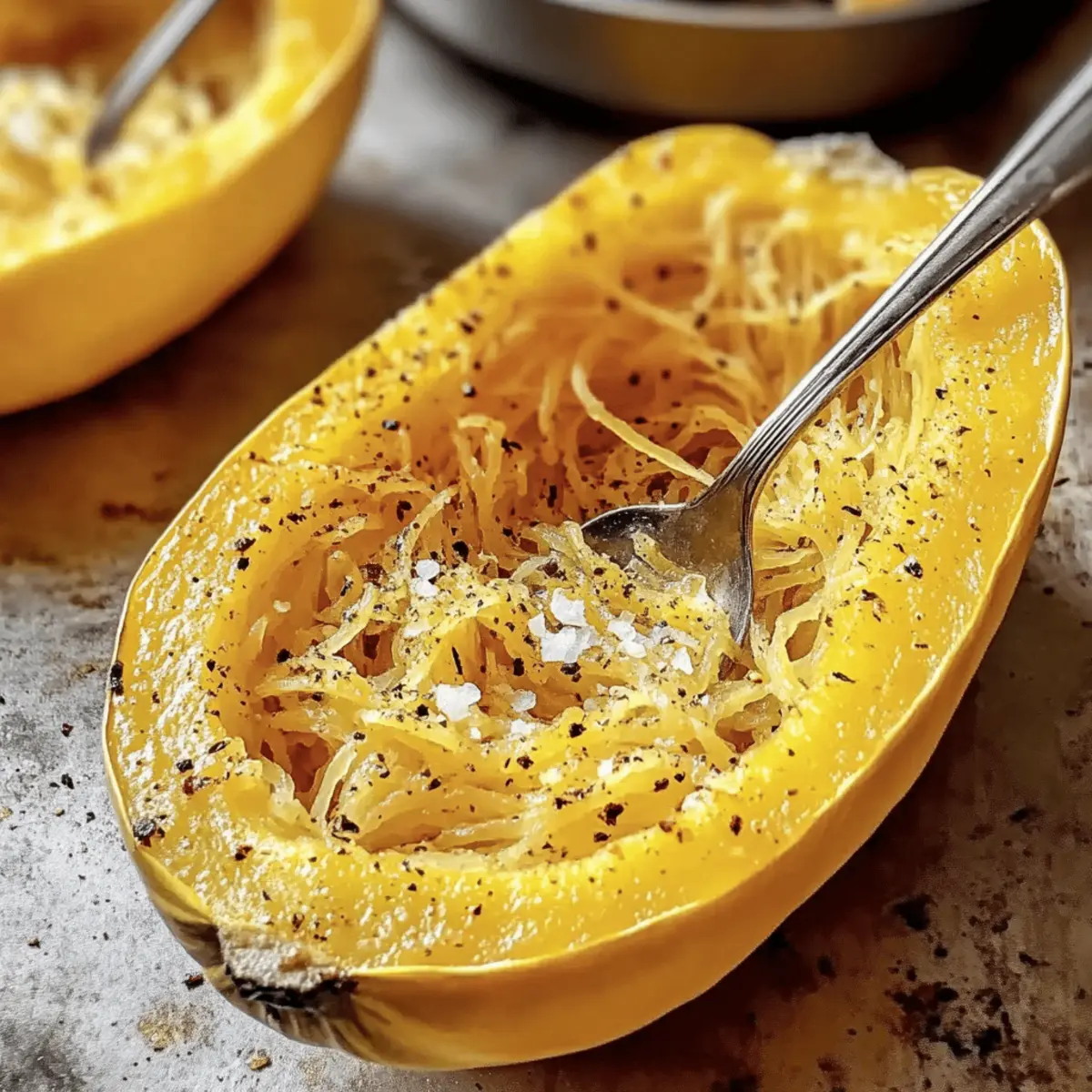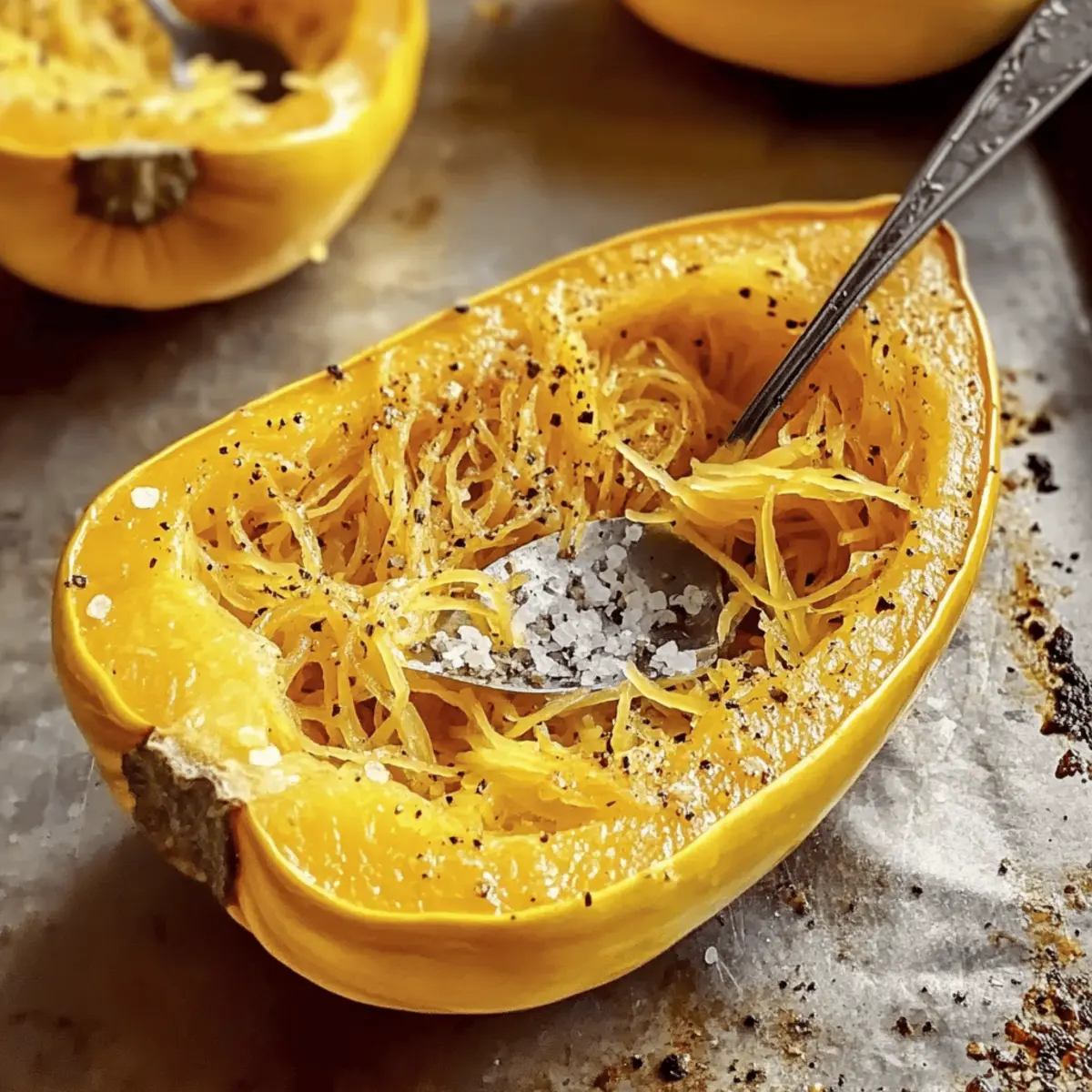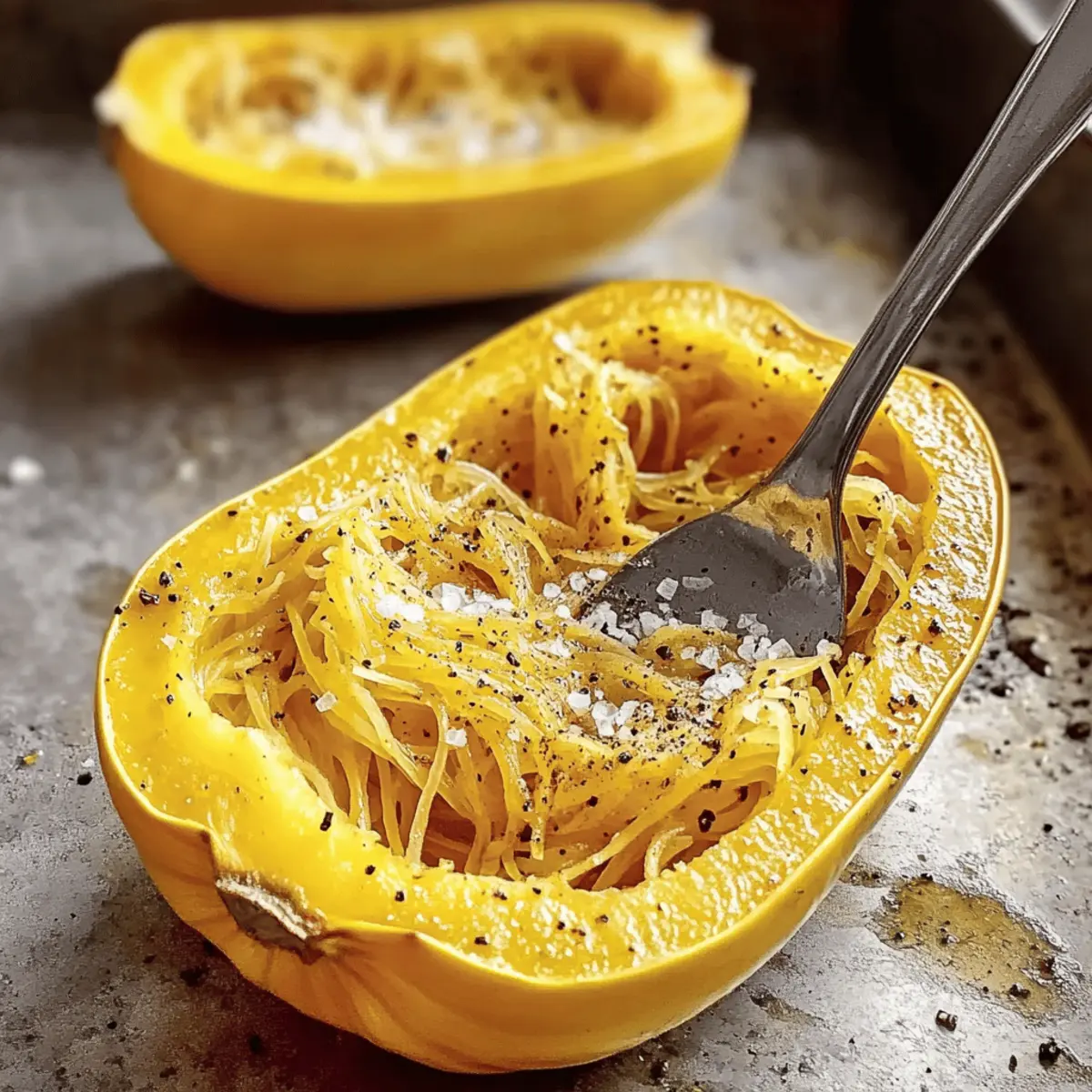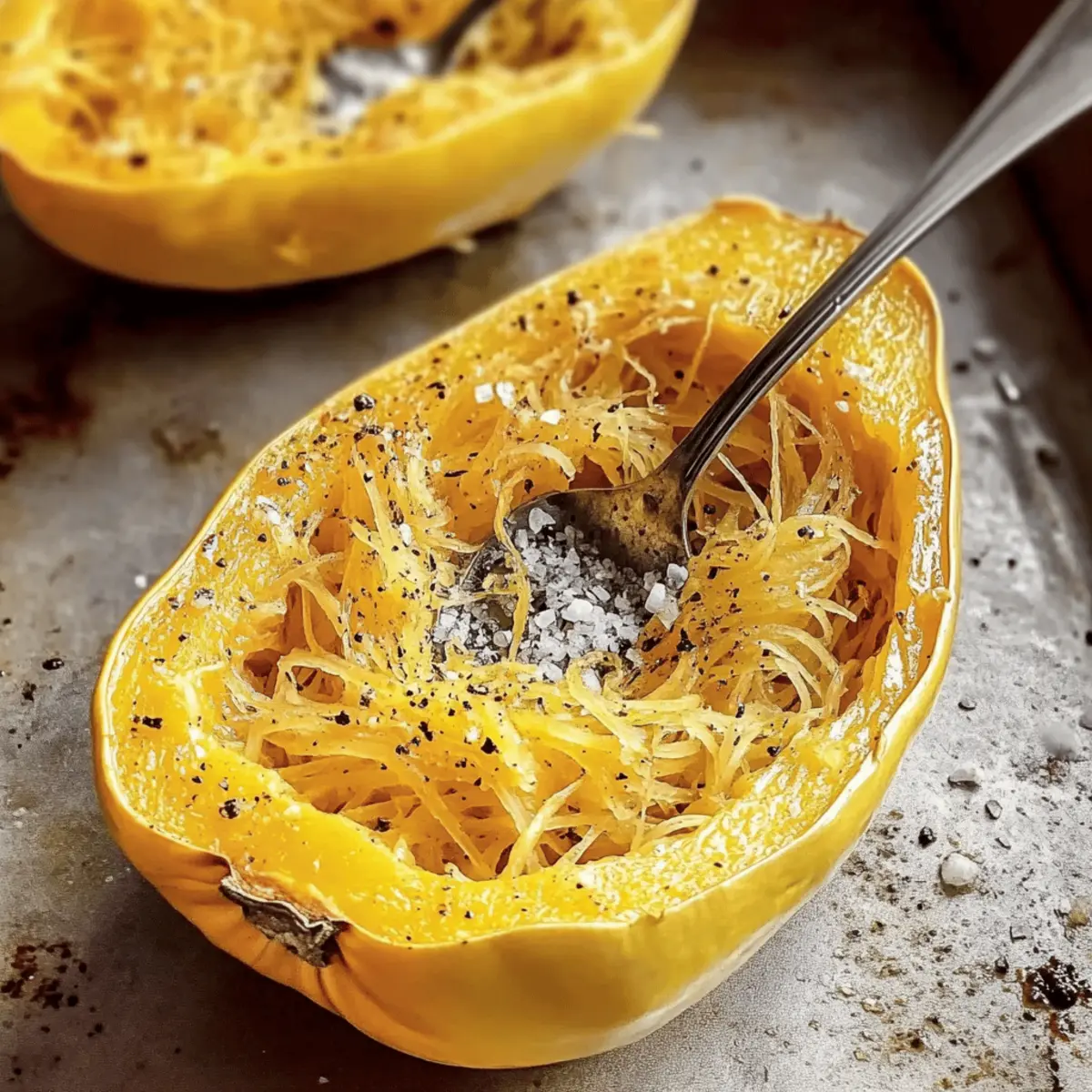As I stood in my kitchen, the aroma of roasted vegetables wafting around me, I couldn’t help but smile at the vibrant spaghetti squash nestled on my countertop. This simple roasted spaghetti squash is not just a dish; it’s a culinary delight that magically transforms into pasta-like strands, offering a healthy, low-carb alternative for those seeking to break free from the weight of traditional pasta. The best part? It’s incredibly easy to prepare and incredibly versatile! Whether you dress it with marinara sauce for a classic Italian twist or toss it with fresh veggies and a sprinkle of cheese, it fits seamlessly into any meal. With this comforting side dish, you can satisfy your cravings while maintaining your healthy lifestyle. Curious about how to bring this wholesome goodness to your table? Let’s dive into the delicious world of roasted spaghetti squash!

Why is Roasted Spaghetti Squash Amazing?
Health Benefits: Roasted spaghetti squash is naturally low in calories, making it an excellent choice for those looking to maintain a healthy diet. Versatile Toppings: From marinara sauce to sautéed veggies, it pairs beautifully with varied flavors, inviting endless creativity in your kitchen. Easy Preparation: With just a few simple steps, you can create this dish without culinary expertise. Crowd-Pleaser: Gaining rave reviews from both veggie lovers and pasta enthusiasts alike, it’s perfect for family gatherings. If you love pasta alternatives, check out our Monterey Chicken Spaghetti for another delightful twist!
Roasted Spaghetti Squash Ingredients
Unlock the flavors of this delightful side dish!
For the Squash
- Spaghetti Squash – The star of the dish, offering a unique texture reminiscent of pasta; choose a medium-sized, heavy squash.
- Extra-Virgin Olive Oil – Adds delicious flavor and helps with even roasting; avocado oil or melted butter can work as substitutes.
- Kosher Salt – Essential for enhancing the natural flavors of the squash; feel free to swap for table salt, but adjust the amount to taste.
- Ground Black Pepper – Brings a hint of warmth and depth to the dish; you can use white pepper for a milder version.
Enjoy the artistry of cooking with roasted spaghetti squash—a healthy, vegan-friendly, gluten-free, low-carb side dish that everyone will love!
Step‑by‑Step Instructions for Roasted Spaghetti Squash
Step 1: Preheat and Prepare the Baking Sheet
Begin by preheating your oven to 400°F (200°C). While the oven warms up, line a baking sheet with parchment paper for easy cleanup. This will be the surface where your spaghetti squash beautifully roasts, allowing excess moisture to escape while it cooks.
Step 2: Trim the Squash
Using a sharp kitchen knife, carefully trim both ends of the spaghetti squash to create stable flat surfaces. This will make it easier to handle while cutting. Set the squash upright on one of the trimmed ends to prepare for slicing, ensuring safety during the next step.
Step 3: Halve the Squash
With the squash stable, slice it in half lengthwise. This ensures you achieve the long, spaghetti-like strands when cooked. Once halved, use a spoon to scoop out the seeds and stringy insides—discard them or save the seeds for roasting later.
Step 4: Season the Squash
Take the two squash halves and drizzle approximately ½ teaspoon of extra-virgin olive oil on the cut sides. Sprinkle with kosher salt and ground black pepper to taste. With your hands, rub the seasonings into the flesh, ensuring an even coating that enhances flavor as it roasts.
Step 5: Roast the Squash
Place the seasoned squash halves cut-side down on your prepared baking sheet. Slide the baking sheet into the preheated oven and set a timer for 35-40 minutes. The squash is done when it’s tender and the edges are slightly caramelized, which adds to its sweet and savory flavor.
Step 6: Check for Doneness
As you approach the 35-minute mark, check the squash for doneness by gently pressing the skin with your finger. When it yields slightly but feels firm, it’s ready to come out. Avoid overbaking, as this leads to soggy strands that detract from the dish’s texture.
Step 7: Flip and Fluff the Squash
Once perfectly roasted, carefully remove the baking sheet from the oven. Using tongs, turn the squash halves cut-side up. Let them cool for a few minutes, making handling easier, then take a fork to fluff the insides, creating long, noodle-like strands ready to be enjoyed.
Step 8: Serve and Enjoy
Now that your roasted spaghetti squash is perfectly fluffed, serve it as is or customize with your favorite toppings. Whether you drizzle marinara sauce over it, toss in some sautéed vegetables, or pair it with grilled chicken, this healthy, low-carb side dish will brighten your meal!

Expert Tips for Roasted Spaghetti Squash
- Cut Lengthwise: Always slice the spaghetti squash lengthwise to achieve those perfect long strands; cutting it crosswise won’t yield the desired texture.
- Check Doneness Early: Start checking for doneness at the 35-minute mark; overbaking can turn the strands mushy, ruining the dish’s appeal.
- Cool Before Handling: Let the squash cool for a few minutes after roasting; this will make it easier to handle and fluff effectively.
- Oil for Flavor: Don’t skimp on the olive oil; it enhances flavor and prevents sticking while roasting your spaghetti squash.
- Experiment with Toppings: Be creative with your toppings! Roasted spaghetti squash works beautifully with marinara, pesto, or even sautéed veggies for variety.
Roasted Spaghetti Squash Variations
Feel free to get creative with your roasted spaghetti squash and make it uniquely yours!
-
Dairy-Free: Substitute traditional cheese toppings with nutritional yeast for a cheesy flavor without dairy.
-
Spicy Kick: Add a pinch of red pepper flakes before roasting to infuse a subtle heat that will tantalize your taste buds.
-
Herb-Infused: Mix fresh herbs like rosemary or thyme into the seasoning for an aromatic twist that elevates the dish’s flavor.
-
Savory Garlic: Toss minced garlic in the olive oil before drizzling it on the squash to create a fragrant, delicious base.
-
Protein Boost: Top with shredded chicken or turkey for a heartier meal, perfect for fueling your family with energy post-workout.
-
Mediterranean Flare: Drizzle with a mixture of lemon juice and za’atar after roasting and enjoy the vibrant, zesty flavors this brings.
-
Veggie Medley: Stir in roasted bell peppers and zucchini into the strands post-roasting for an explosion of color and nutrients.
-
For another delicious pasta alternative to try, don’t forget to check out our Spicy Southern Cheesy Chicken Spaghetti Casserole for a delightful twist on comfort food!
Make Ahead Options
Roasted spaghetti squash is a fantastic meal prep option that can save you valuable time during busy weeknights! You can cut and scoop the squash up to 24 hours in advance, storing the halves in an airtight container in the refrigerator to keep them fresh. Just remember to drizzle a bit of olive oil and season them before storage to maintain flavor. When you’re ready to serve, simply season, roast them as instructed, and fluff the strands. Enjoy your roasted spaghetti squash as a nutritious, low-carb side dish without the last-minute rush!
How to Store and Freeze Roasted Spaghetti Squash
Fridge: Store cooled roasted spaghetti squash in an airtight container for up to 5 days. This keeps it fresh and flavorful, ready to enjoy as an easy side dish.
Freezer: If you want to keep the spaghetti squash longer, freeze portions in airtight bags or containers for up to 6 months. Thaw in the refrigerator before reheating to maintain texture.
Reheating: To reheat, simply place the squash in the microwave or oven. If using the oven, cover it with foil and heat at 350°F (175°C) until warmed through, which prevents drying out.
Serving Leftovers: You can toss leftover roasted spaghetti squash into salads or soups, making a scrumptious addition to your meals!
What to Serve with Roasted Spaghetti Squash
There’s something magical about pairing warm, tender spaghetti squash with various sides that perfectly enhance its sweet flavor.
- Garlic Bread: This classic companion offers a crunchy texture and aromatic garlic kick, inviting everyone to indulge in the meal.
- Sautéed Vegetables: An array of colorful bell peppers and zucchini adds freshness and a satisfying crunch, balancing the dish’s natural sweetness beautifully. Toss them with garlic and olive oil for extra flavor.
- Marinara Sauce: This rich, tomato-based sauce clings perfectly to the squash strands, transforming your dish into a comforting Italian feast that’s low in carbs.
- Pesto Chicken: Juicy grilled chicken with a fresh basil pesto drizzle creates a protein-packed, hearty option that pairs perfectly with the airy squash threads.
- Quinoa Salad: Light and fluffy quinoa mixed with cherry tomatoes and cucumbers brings a refreshing crunch and added nutrients, making your plate vibrant and colorful.
- Red Wine: A smooth red wine, like Chianti, harmonizes with the sweet and savory elements of the dish, creating a delightful dining experience that lingers with each sip.
- Mixed Green Salad: A simple salad with arugula, walnuts, and a balsamic vinaigrette introduces an earthy flavor and a crisp texture that complements the roasted squash wonderfully.
- Roasted Chickpeas: These crispy, seasoned legumes add a satisfying crunch and protein boost, making your meal both nutritious and delicious.
- Lemon Sorbet: A refreshing end to your meal, lemon sorbet cleanses the palate while offering a sweet and tangy finish to round off the delightful dining experience.

Roasted Spaghetti Squash Recipe FAQs
How do I choose a ripe spaghetti squash?
Absolutely! When selecting a spaghetti squash, look for one that feels heavy for its size with a smooth, firm skin, free from dark spots or blemishes. A medium-sized squash is usually perfect for roasting since it yields the right amount of strands.
How should I store leftover roasted spaghetti squash?
Very easy! Store any cooled roasted spaghetti squash in an airtight container in the refrigerator for up to 5 days. This helps keep the flavors intact and makes for a quick side dish or meal addition later on!
Can I freeze roasted spaghetti squash?
Yes, you can! To freeze, portion the cooled squash into airtight freezer bags or containers, removing as much air as possible. It can be stored for up to 6 months. When you’re ready to use it, simply thaw in the refrigerator overnight before reheating.
What if my spaghetti squash turns out mushy?
Don’t worry, it happens! If your spaghetti squash becomes mushy, it likely means it was overcooked. To achieve the perfect texture, start checking for doneness around the 35-minute mark. For next time, ensure it’s tender but still slightly firm to the touch to retain that delightful spaghetti-like quality.
Is roasted spaghetti squash safe for pets?
Absolutely! Roasted spaghetti squash is dog-friendly, but it should be offered in small portions. Just ensure there’s no added salt or seasoning. Always consult with your vet if your furry friend has any dietary restrictions before serving new foods.
What toppings can I add to my roasted spaghetti squash?
The more the merrier! Roasted spaghetti squash pairs beautifully with a variety of toppings. You can add marinara sauce and a sprinkle of parmesan for a classic Italian flair, mix it with sautéed vegetables for extra nutrients, or even drizzle some pesto on top for a fresh twist. Get creative—your taste buds will thank you!

Roasted Spaghetti Squash: A Sweet and Satisfying Side Dish
Ingredients
Equipment
Method
- Preheat your oven to 400°F (200°C) and line a baking sheet with parchment paper.
- Trim both ends of the spaghetti squash to create stable flat surfaces.
- Slice the squash in half lengthwise and scoop out the seeds.
- Drizzle approximately ½ teaspoon of olive oil on the cut sides, and sprinkle with salt and pepper to taste.
- Place the seasoned squash halves cut-side down on the baking sheet and roast for 35-40 minutes.
- Check for doneness by pressing the skin; it should yield slightly.
- Remove from the oven, turn the squash cut-side up, and fluff the insides with a fork.
- Serve as is or add your favorite toppings.

Leave a Reply